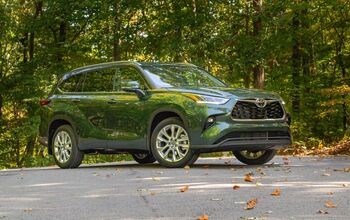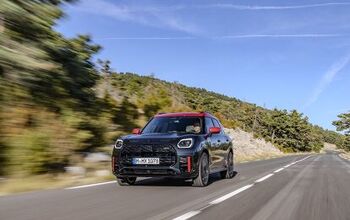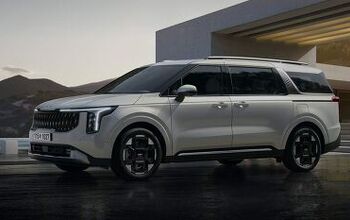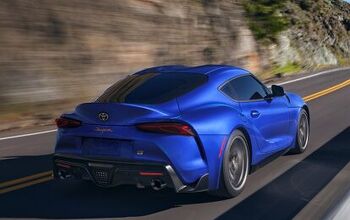2010 Toyota Highlander Review
We could follow the herd and go on about Toyota’s recall woes, or the fact that the Highlander is one of the ones affected by the sticking accelerator issue, but we won’t. Instead we’ll talk about this mid-size car based SUV, looking at both its strengths and weaknesses – in essence performing one of our regular AutoGuide reviews.
FAST FACTS
| 1. The Highlander is offered with either a 187-hp 4-cyl or a 270-hp V6 with 20/27-mpg (city/hwy) and 16/21-mpg respectively. |
| 2. Three rows of seating are standard, with 10.3 cubic feet of trunk space, 42.3 cu.-ft. with the third row seats folded flat and a total of 95.4 cu.-ft. |
| 3. Toyota offers a tow prep package on the Highlander that adds a 240-watt cooling fan, heavy-duty radiator and oil cooler. With it, towing capacity is rated at 5000 lbs. |
| 4. Options include a multi-function 3.5-inch display screen, with back up camera is (offered on Sport and Limited models) and multi-stage heated front seats. |
MARKING TIME
The Highlander was introduced in 2000, for the 2001 model year, with the current generation vehicle arriving for 2008. For 2010, there are few changes – Highlander being offered in three trim levels, Base (starting at $25,585); Sport ($31,650) and Limited $34,670), with a choice of four-cylinder and V6 engines, plus the option of front and four-wheel drive. The original Highlander was among the second wave of car-based crossovers, vehicles that were designed to combine the high driving position of a traditional SUV with the on-road refinement of a standard passenger car. Built off the Toyota Camry platform, it probably isn’t surprising that Highlander boasts similar features and character (no snickering here please).
Get a Quote on a New Toyota HighlanderWhat does strike you about this vehicle is its size. Measuring 188.4-inches in length, 75.2-inches across and tipping the scales at close to 4,000 lbs, its not far off some Detroit big cars of decades past. However, on the outside, it boasts workmanship that appears far better than those old mastadons. Run your finger between the door and fenders and you’ll find that everything lines up pretty much as it should. The same goes for the hood and rear hatch lid, areas where, even on many modern vehicles, alignment can still be questionable at times. As for paint finish; amid the cost cutting currently prevalent in much of the auto industry, it’s suitably glossy, with orange peel generally noted by its absence, even on dark colored examples.
Climb in and anybody familiar with Toyotas will feel instantly at home. The instrument panel and switchgear have a chunky, no-nonsense feel to them. Everything is well laid out and the gauges easier to read than some of this manufacturer’s other offerings (Tundra you know who you are).
PLENTY OF ROOM FOR PASSENGERS AND CARGO
The seats, while perhaps a bit dated in looks (we’re talking cloth pattern here), are decently designed with ample rear, thigh and back support. They’re also surprisingly comfortable. Second row legroom is adequate, with 38.3-inches to stretch the legs, but where interior space makes its biggest impact is head clearance – more than 40-inches, all the way back, aided by a fairly angular roof line. The optional third row seating is okay, but the biggest problem is getting in and out. Precisely for that reason and with just 29.9-inches of stretching room, it’s best reserved for kids and younger adults. Both second and third rows easily fold forward, resulting in 95.4-cubic feet of cargo volume – allowing you to load in long and bulky objects with few problems.
In terms of feature content, the Highlander comes with a bunch of standard safety kit – front, side, curtain and even driver knee airbags, active front head restraints and standard driver aids such as traction control and anti-lock brakes. A tilt and telescoping steering wheel is standard, while the front chairs are height adjustable, allowing for good driving posture and comfort. Air conditioning is standard and the HVAC controls far simpler to operate than some others in the class. The AM/FM/CD stereo is okay, but seems a touch anachronistic in this day and age, both in design and function, though it does include digital media player connection. A multi-touch 3.5-inch center screen, with a rear backup camera, navigation system, Sirius/XM satellite radio and rear seat DVD entertainment are offered, but start being generous with order sheet and you’ll find they’ve added more than $4,000 to the Highlander’s sticker price.
4-CYLINDER OR V6? GLACIAL OR SPORTY?
Given the Highlander’s fairly substantial curb weight, you’d probably think that acceleration and overall performance would lean toward the glacial side of the scale. Two powertrain combinations are offered on the regular 2010 model, a 2.7-liter four-cylinder engine, teamed with a six-speed automatic and a 3.5-liter V6 that, curiously, comes with a five-speed slushbox. Rated at 187 horsepower at 5100 rpm and just 186 ft-lbs of torque at 4100 revs, the four-cylinder is not the best choice for this type of vehicle. Under load it’s fairly gruff and noisy, with acceleration somewhat sluggish, particularly when negotiating freeway on ramps and traversing hills.
The V6, which cranks out 270-hp at 6200 rpm and 248 ft-lbs at 4800, by contrast, turns this thing into a bit of a hot rod, despite peakier power delivery. Goose the throttle and it just wants to go. On numerous occasions, we found ourselves chirping the tires with barely any throttle input. Acceleration with this engine is turbine smooth and rather satisfying, plus the five-speed automatic works well. If you plan on doing any towing at all with your Highlander, the V6 is a must as is the optional tow package, which boosts yanking capacity to 5,000 lbs thanks to such goodies as a heavy duty cooling system and higher capacity alternator. The penalty, however, is fuel economy; the V6 getting 17 miles per gallon in town and around 23 on the highway, not aided by having just five cogs. The four-banger does better in this regard – 20/27-mpg city/highway. Mind you, it does have an extra gear to work with. The V6 is also available with all-wheel drive and gets 17/23 mpg.
SOFT BUT SUITABLE
As with many modern Toyotas, (car or SUV), ride quality is fairly soft. The Highlander tends to float over bumps, but while it might appear mushy for more performance oriented types, the chassis tuning is ideally suited for longer trips and rough roads, which plague much of the North American continent. Of course, the trade-off is fairly slushy handling. The steering is quite highly boosted and through the turns the Highlander tends to plow, aided by fairly small and narrow tires by modern crossover standards. The bigger 19-inch rims and rubber offered on Sport and Limited models make quite a noticeable difference in grip and on wet roads. The added traction provided by Toyota’s active four-wheel drive system, actually makes it less prone to oversteer. That said, and despite the traction and stability control taking a fairly active roll under more enthusiastic driving, it’s best to leave the grandstanding to the kids in their Supras and AE86s; the Highlander is more about holding its own in every day driving situations.
Standard four-wheel disc brakes with anti-lock are fitted, but like the handling and steering, the stopping sensation feels a bit numb at times and under panic stops things can get a bit unsettled, though in our evaluation we felt this was down more to the tires than anything else.
THE VERDICT
While there are newer mid-size crossovers on the market, the Highlander still has many attributes that make it a worthy choice as a family truckster, including decent build quality, good feature content, a comfortable ride and a surprisingly capacious interior. In many respects it’s the modern version of a 1980s Ford Country Squire, without the wood paneling. No doubt Clark Griswold would approve.
RELATED READING
2009 Honda Pilot
2009 Chevrolet Traverse Review
2008 Buick Enclave CXL Review
2010 GMC Acadia SLT-2 AWD Review
2009 Ford Flex Review
2011 Kia Sorento: First Drive
2009 Hyundai Santa Fe Limited AWD
2009 Ford Edge
2009 Mazda CX-9
2009 Nissan Murano
2010 Lincoln MKT AWD
2009 Mitsubishi Outlander
2010 Subaru Outback: First Drive
2010 Honda Accord Crosstour EX-L Review
2009 Toyota Venza Review
2008 Subaru Tribeca Review
2010 Chevrolet Equinox 1LT AWD Review
2010 GMC Terrain SLT-2 Review
2009 Dodge Journey SE Review
LOVE IT
- Gutsy acceleration (V6)
- Good build quality
- Capacious interior
LEAVE IT
- Glacial acceleration (4-cylinder)
- Ponderous handling
- Options can really jack up the price
More by Huw Evans





































Comments
Join the conversation